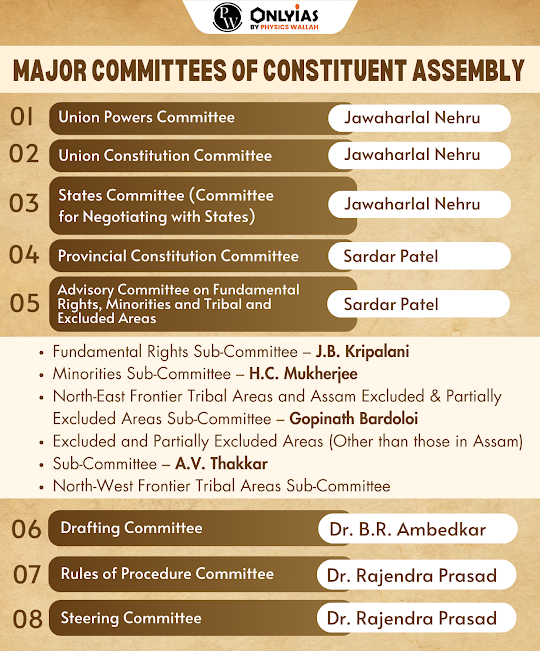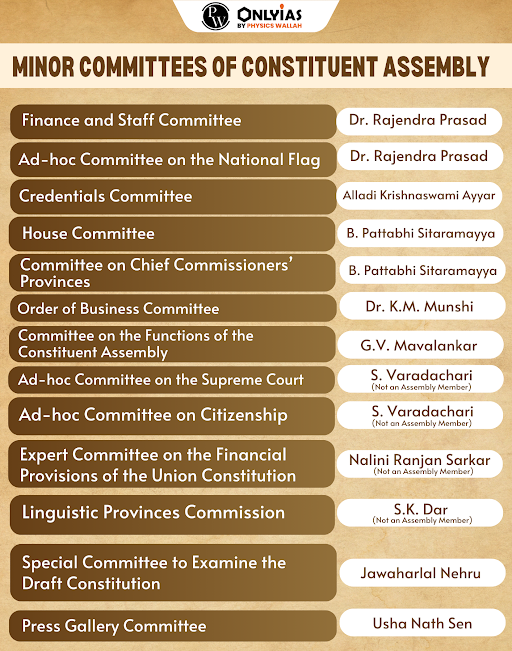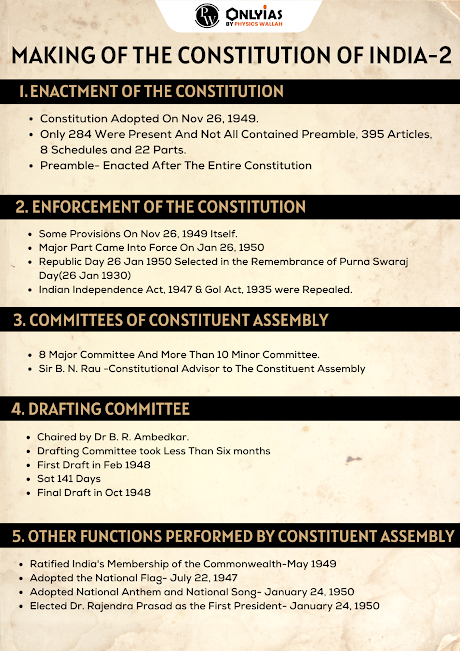Constituent Assembly of India: Democracy, Overcoming Critiques & Building a Lasting Legacy |
Role of Major Committees in the Constituent Assembly: Architects of Democracy
These committees were instrumental in addressing key issues such as union powers, the union constitution, state negotiation, provincial constitution, fundamental rights, minorities, tribal and excluded areas, drafting the constitution, and establishing the rules of procedure.
- Together, they worked meticulously to ensure that the Indian Constitution embodied the diverse aspirations and values of the newly independent nation.
- In the constituent assembly, eight were major committees and the others were minor committees.
| Also Read: CONSTITUTIONALISM IN INDIA: A HISTORICAL PERSPECTIVE AND CONSTITUTIONAL TRANSITION |
Minor Committees in India’s Constituent Assembly
Crucial Contributions of Constituent Assembly, Committees & the Drafting Committee in Crafting India’s Constitution
The Pivotal Role of the Drafting Committee: Architects of Liberty
- Establishment of the Drafting Committee: Among all the committees within the Constituent Assembly, the Drafting Committee held unparalleled significance.
- It was formed on August 29, 1947, and entrusted with the monumental task of preparing a draft for the new Constitution of India.
- Committee Members: The Drafting Committee comprised seven members, These eminent individuals were entrusted with the responsibility of shaping the constitutional document.
-
- With Dr. B.R. Ambedkar served as the Chairman.
- N. Gopalaswamy Ayyangar,
- Alladi Krishnaswamy Ayyar,
- Dr. K.M. Munshi,
- Syed Mohammad Saadullah,
- N. Madhava Rau (replacing B.L. Mitter),
- T.T. Krishnamachari (replacing D.P. Khaitan).
- First Draft and Public Consultation: The Drafting Committee, after carefully considering the recommendations of various committees, prepared the first draft of the Indian Constitution.
- This initial draft was published in February 1948, and the people of India were granted a crucial eight-month window to discuss the draft and suggest amendments.
- Preparation of the Second Draft: The Drafting Committee subsequently prepared a second draft, which was made public in October 1948.
- Remarkably, the committee completed its drafting work in less than six months.
- A Swift and Focused Process: The Drafting Committee’s dedication and efficiency were evident in the fact that the committee met for a total of only 141 days to accomplish this monumental task, underscoring the speed and precision with which the Indian Constitution was crafted.
- In summary, the Drafting Committee played a pivotal role in shaping the Indian Constitution, working diligently and swiftly to prepare the drafts and ensuring a comprehensive and consultative process with the people of India.
- This committee’s dedication and leadership were instrumental in the successful creation of the foundational document of independent India.
| Also Read: INDIAN CONSTITUTION: DIVERSITY, GLOBAL PERSPECTIVES AND, UNIQUE FEATURES |
Historic Functions Performed by Constituent Assembly: Nurturing the Nation
- Making of the Constitution and enacting of ordinary laws
- India’s membership in the Commonwealth was ratified in May 1949.
- On July 22, 1947, adopted the National Flag.
- On January 24, 1950, Adopted the National Anthem and the National Song.
- On January 24, 1950, Dr. Rajendra Prasad was elected as India’s inaugural President.
Critiques & Challenges Faced by the Constituent Assembly
- Congress Domination: One of the primary criticisms leveled at the Constituent Assembly was the dominance of the Indian National Congress.
- With 208 seats held by Congress members, critics argued that it was essentially a one-party body in a nation that functioned as a one-party state.
- Renowned constitutional expert Granville Austin even remarked, “The Constituent Assembly was the Congress, and the Congress was India.”
- Lack of Direct Representation: Another criticism focused on the indirect mode of member selection.
- Members were not directly elected by the entire Indian population through universal adult suffrage.
- Instead, some were partly elected under limited franchise while others were nominated.
- Question of Sovereignty: Critics contended that the Constituent Assembly was not a sovereign body, highlighting that it was formed based on the proposals of the British Government.
- They noted that the assembly’s proceedings were conducted with the permission of the British Government, raising concerns about its true independence.
- Time Consuming Process: The protracted duration of the constitution-making process came under scrutiny. Critics argued that the assembly took excessively long to draft the Constitution.
- Naziruddin Ahmed coined the term “Drifting Committee” to express dissatisfaction with the prolonged duration taken by the Drafting Committee.
- Naziruddin Ahmed coined the term “Drifting Committee” to express dissatisfaction with the prolonged duration taken by the Drafting Committee.
- Lawyer-Politician Dominance: Another critique was the overrepresentation of lawyers and politicians within the assembly. Critics argued that other sections of society were not adequately represented.
- This legal-political dominance influenced the document’s content and structure leading to the bulky nature of the Constitution.
- Allegations of Community Dominance: There were allegations of Hindu dominance within the Constituent Assembly. Some critics contended that it was primarily a Hindu-dominated body.
- Lord Viscount Simon referred to it as ‘a body of Hindus,’ and Winston Churchill remarked that the assembly represented ‘only one major community in India,’ suggesting an imbalanced representation.
- In summary, the Constituent Assembly faced criticism for its perceived Congress domination, lack of direct representation, questions regarding its sovereignty, the lengthy drafting process, overrepresentation of lawyers and politicians, and allegations of community dominance. These criticisms shed light on the complex and multifaceted nature of the constitution-making process in post-independence India.
Dr. B.R. Ambedkar and the Constituent Assembly
Why did he oppose the Constituent Assembly?
Despite his initial reservations, Dr B. R. Ambedkar joined the Constituent Assembly. This could have been a result of political pragmatism because,
|
| Also Read: LEGISLATIVE COUNCIL EVOLUTION: CHARTER ACT TO MORLEY MINTO REFORMS |
Important Facts About Indian Constitution and Constituent Assembly
Time Taken by the Framers of Constitutions in Other Countries:
|
Conclusion
- Crafted through debates and compromises, the Indian Constitution embodies the aspirations of a free and democratic nation.
- It stands as a beacon of endurance and progress, providing a sturdy framework for India’s diverse democracy.
- Safeguarding rights and fostering equality, it remains a testament to India’s commitment to justice and democracy.
| Also Read: CHARTER ACT 1813 AND 1833: TRANSFORMING TRADE AND IMPERIAL AUTHORITY IN INDIA |

 GS Foundation
GS Foundation Optional Course
Optional Course Combo Courses
Combo Courses Degree Program
Degree Program














